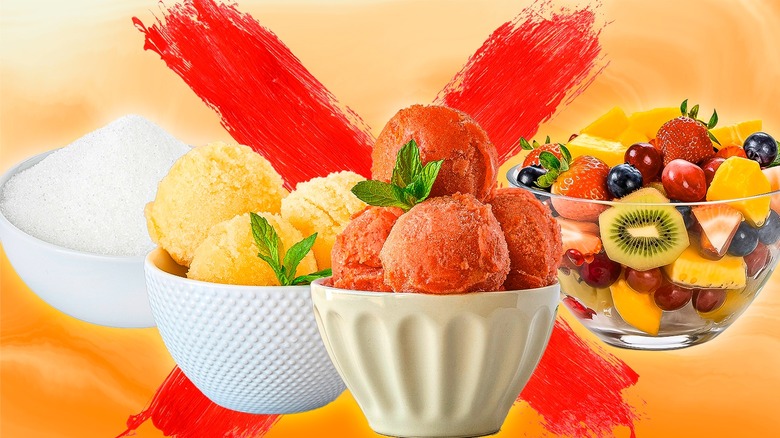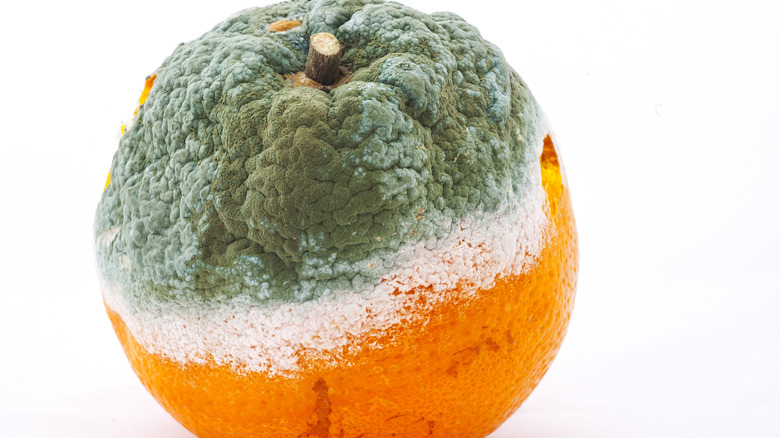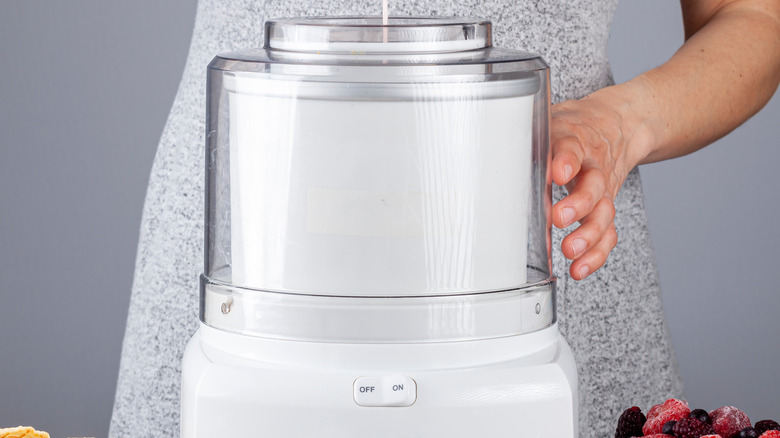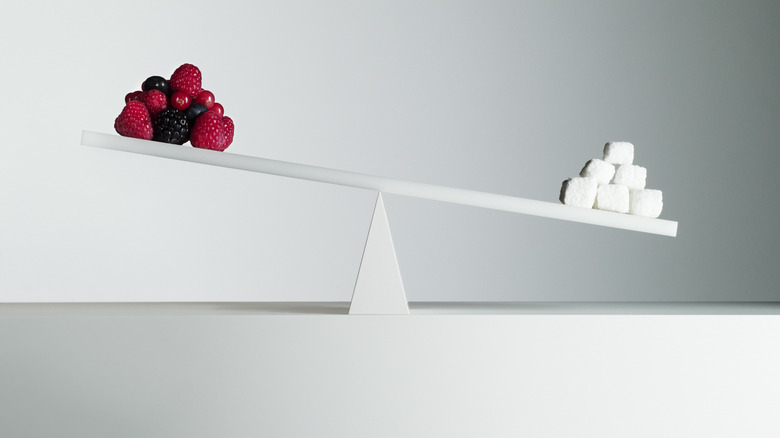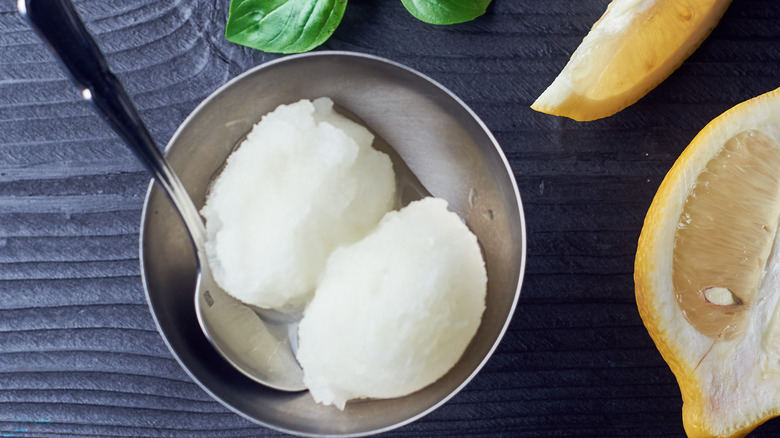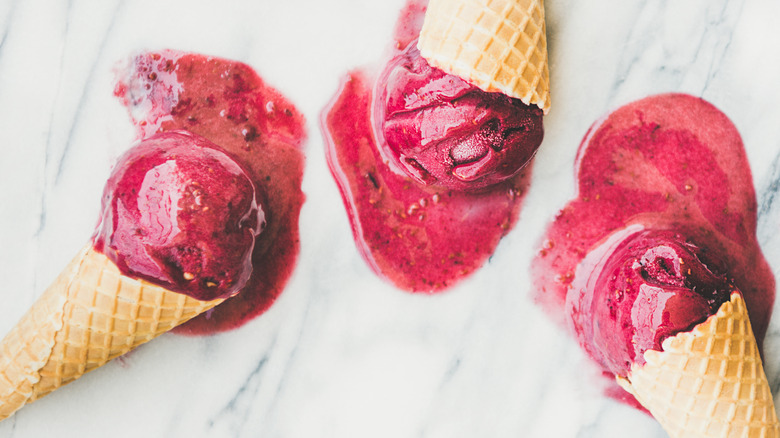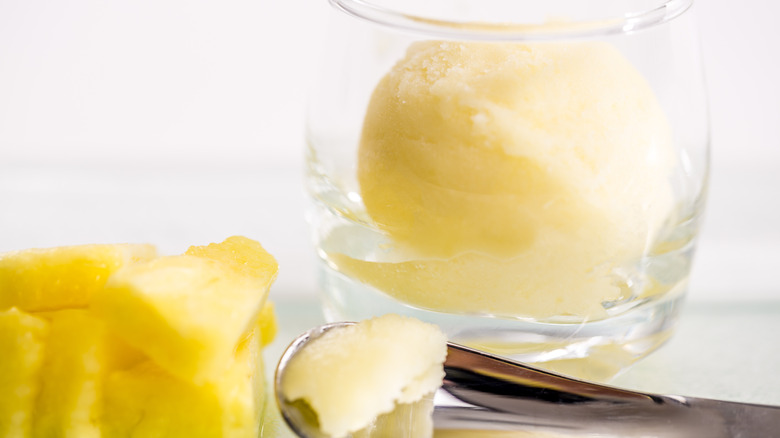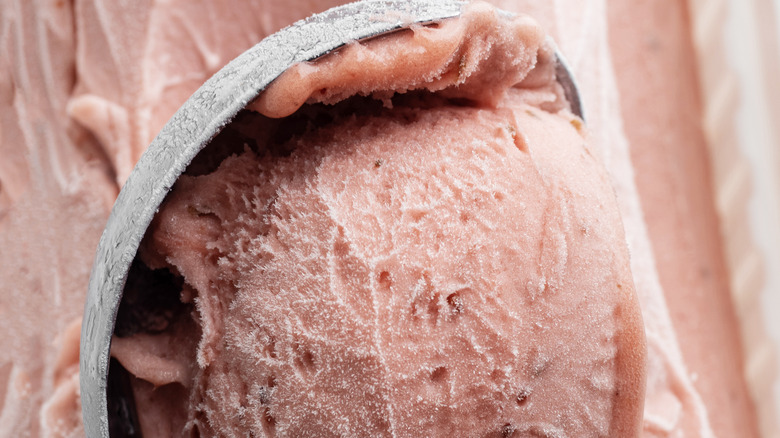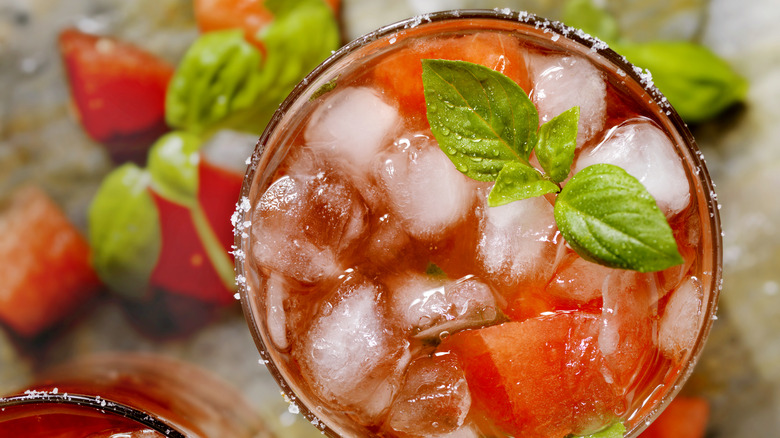10 Mistakes To Avoid When Making A Refreshing Sorbet
Sorbet made right is hard to beat. It's creamy, cold, and satisfying. And making your sorbet — not buying it premade — is a rewarding endeavor, one that takes little time and delivers in a big way. Making your own sorbet also gives you a chance to unleash your creativity. You can play with the ingredients, perfect the texture, and get the flavor right. Sorbet is a chameleon dessert that will adjust to fit your mood. If it's a hot, sunny day, you need only a scoop on a cone. If you're preparing for an elegant occasion, bring out the crystal dessert dishes, add a berry or yogurt sauce, and a Sumatra espresso. If it's fall or winter, choose grapes or blood oranges. Want to show off? Use that homemade sorbet in a stellar dessert like baked Alaska. From mango to Moscow mule, and from lemon verbena to spiced apple cider, there's a refreshing sorbet flavor to please just about anyone. Although sorbet, gelato, sherbet, and granita are closely related, sorbet — unlike ice cream and sherbet — is dairy-free, so it's the perfect choice for those following a vegetarian or vegan diet.
There's another side to sorbet that's not quite so elegant. Cold brick, anyone? Watery, sherbet puddle in a dish? Sticky texture? We've all had sorbet go south, and for many, the fear of repeating that disaster keeps them from enjoying this versatile treat. No more, though. Avoid these errors, and your sorbet will turn out every time.
Inferior fruit
Sorbet demands your very best fruit. That burst of natural flavor is part of what makes sorbet such a favorite. That too-soft orange and that box of past-their-prime cherries will result in an inferior taste. Sorbet is such a simple concoction that you can present your fruit without drenching it in exotic syrups or burying it between cake layers. Ideal fruits include blueberries, cherries, citrus, melons, stone, and grapes. Whether to cook the fruit first is your choice. For instance, grilled pineapple will create a very different flavor from fresh. You can also roast fresh fruit for a more flavorful sorbet. It depends on the fruit. Some taste better cooked, and some have a better texture and flavor when you add them without cooking.
But what happens if you're craving sorbet and can't access fresh fruit? Does that mean you'll have to wait for spring to make sorbet? Not with frozen fruit at your fingertips. It's an ideal second choice. You can use frozen berries for a flavorful three-ingredient strawberry sorbet using only strawberries, sugar, and lemon juice. Canned fruit can work in a pinch. If you have the will, you can find a way to make the best sorbet. Just focus on the fruit first. It determines everything.
Using the wrong tools
Your favorite scrambled egg whisk is not going to do this job. Unless you get very basic, you will need to churn your sorbet, which means you'll need an ice cream maker. This approach will give you a smoother sorbet because it will break up the sugar crystals and create a creamy texture. Still, it's doubtful that you'll run out and buy an ice cream maker the first time you try to make sorbet. You can still use the traditional freezer approach, although your finished sorbet may be closer to the texture of icier granita. Use the basic proportions of one part sugar to four parts fruit, but remember that is just a general rule, and sorbet is specific.
Some juicers come with sorbet attachments, and you can also purchase frozen dessert makers targeted to sorbets. You need only a device to whip air into your fruit purée. The ideal tool for that is something you already own. Consider trying the freezer approach first, and if you decide to make sorbet regularly, invest in a specific tool. A high-speed blender is another useful must-have for reducing fruit. It's also helpful when working with frozen grapes or berries. Just toss the frozen berries into the blender with sugar, lemon juice, and any additional flavors you choose. An immersion blender is another handy tool when breaking down fresh fruit. It's easy to store and clean and will whirl that fruit into a perfect purée.
Too little sugar
You're making sorbet, a dessert that's impressive and elegant. This is not the time to skimp on the sugar. When you add sugar, remember that the frozen version will not taste as sweet as the purée before you freeze it. And sorbets need sugar for more than flavor. Sugar helps the mixture achieve a creamy texture; if you use too little, you will end up with more ice than sorbet. Numerous recipes offer various proportions for sugar and fruit. The most popular is one part sugar to four parts fruit purée. Not all fruit has the same density, so this rule is only a starting place. Adding too much sugar may solve the problem of icy sorbet, but it will also make the mixture slushy. Picture the sugar and fruit on opposite ends of a teeter-totter you are trying to balance equally. In a way, you'll be playing a guessing game until you've experimented a few times. Enter the refractometer. This wonderful device measures the sugar content of your syrup. Then the guessing game stops, and you can tell when you've reached the magic number.
One pantry stable to improve the texture of homemade sorbet is corn syrup. Note that this is not the maligned high-fructose corn syrup. This processed sugar thickening agent will make your sorbet creamier, and adding it will keep ice crystals from forming in your sorbet.
Too much ice
This is the ultimate fear of many who avoid making sorbet. You find the freshest fruit, purée it perfectly, adjust the flavor, and then the moment of truth arrives: The big freeze. That's when you find that you're dealing with nothing but pretty ice. No sauce you create can conceal this big fat brick of a failure. No topping can hide it. You might as well have stopped for ice cream on the way home. But all is not lost. You can probably save yourself from trying to ingest a flavored ice cube. Let it melt, and as you wait for that to happen, go through a mental checklist of ingredients.
Did you go easy on the sugar? If so, add some to increase the creaminess. If you're happy with the amount of sugar you started with, consider adding alcohol or corn syrup. Both will help you achieve that creamy texture you're going for. Alcohol needs a lower temperature than water to freeze, so adding a little vodka, rum, or even whiskey or wine will keep your mixture softer and avoid ice cube syndrome. Remember that just because you followed a recipe, the sweetness of individual fruits differs, and you may need to make adjustments to achieve the sorbet's ideal texture.
Not enough pectin
You had such high hopes for that pomegranate sorbet, but there it is, sitting in your ice cream maker like a puddle or slopping over the side of the cone you so carefully scooped it into. Some fruit lacks pectin, and this fruit will leave your sorbet mixture lacking the proper body. Look up a list of fruits with high pectin and you can still guess wrong with sorbet. Lemons are high in pectin, but it's all found in the lemon peel. When you think of pectin, your first thought is probably jelly or jam. That's what gives it that thick texture. A soluble fiber, pectin shows up naturally in the skins and seeds of fruit. When you bite into a piece of toast loaded with preserves, that thick, chewy mouthfeel is thanks to pectin in the fruit. The texture is similar to what you find when you use gelatin to thicken a fruit mixture, but there's a difference between pectin and gelatin. Unlike pectin, which comes from fruit, gelatin is an animal product, and this makes pectin especially attractive to vegans and vegetarians. Unlike gelatin, pectin is soluble in cold water.
One word that's tossed around a lot by those who make sorbet is stability. You want a stable, creamy concoction that is neither too icy nor soft. Some fruits have enough pectin to get you there; others need help. That's where powered pectin comes in. Start with 1 teaspoon to 1 quart of liquified fruit.
Too lilttle fiber
You could hardly wait to finish making that pineapple sorbet, and now, you're looking at what might end up as a pineapple puddle. Texture is your main challenge when making sorbet. Coming up with enticing flavors is easy. Almost any fruit or fruit mixed with herbs and spices will make you happy you took the time to pull out the ice cream maker and churn this creation. What won't make you happy is getting the texture wrong. Fiber is the key to that. Fruits with the least fiber include melons, pineapple, strawberries, nectarines, and peaches. You're going to have less to work with when you choose these fruits, but they're worth the effort.
Adding powdered pectin is one way to improve the texture. Another way is adding tapioca. Do that, and you'll watch that once-malnourished dessert transform into one with a sorbet with a silky texture. In the unlikely case, you have any leftovers, this sorbet will stay smooth even when you freeze it.
Too watery
Does your sorbet resemble fruit soup? There are any number of reasons you might end up with a too-watery sorbet. One is too much sugar. While too little sugar will give you an icy texture, too much will make the mixture too slushy, and you want something you can scoop up with a spoon — not drink. If your problem is too much sugar, you can solve it by adding more fruit puree. That will lower your ratio of sugar to fruit.
Another problem may be simply time. Maybe you didn't leave your sorbet long enough in the freezer or, if you use an ice cream maker, you may not have churned the mixture long enough. When the sorbet is churned properly, no liquid should remain. You can solve that problem by re-freezing your churning bowl until it is frozen solid. If you're working with already frozen fruit in a food processor, be sure your fruit is fully frozen before you begin. Like most texture problems you'll encounter with sorbet, the best solution is to use an ice cream maker according to directions. That means no shortcuts. If you don't have an ice cream maker and don't want one, consider making granita instead of sorbet. To do that, combine your fruit puree and flavorings put it in a shallow container, and stir occasionally as the mixture becomes slushy and ultimately icy.
Too much alcohol
Alcohol can be your secret boozy addition to a velvety smooth sorbet. A little vodka or other liquor, a little lemon juice, some sweetener, and you're on your way to almost instant smoothness. Alcohol doesn't freeze as fast as water does. Alcohol's freezing point is -16 F, while water won't freeze until it reaches 32 F. If you want to lower the freezing point for water — or a water-based mixture like fruit puree — you can add a little alcohol. But like most things in cooking and life, too much of a good thing can create problems. Too much alcohol will cause your mixture to remain too slushy like that bottle of tequila you stick in the freezer before a party and then forget you had. That tequila is still slushy a week later because the alcohol never got cold enough to freeze. If that's what happened to your sorbet, don't toss it. The only solution is to turn the sorbet into a strawberry margarita or vodka lemonade, which isn't the worst of all possible fates but won't help you create a memorable dessert either.
Another reason you might want alcohol for your sorbet is the flavor. Vodka, for instance, pairs nicely with lemon, and sparkling wine elevates strawberries. You should still pay attention to your proportions because the alcohol you add will affect the overall texture of your sorbet.
Leaving out herbs
If you're serious about your sorbet, don't forget about adding herbs. Sorbets are all about freshness, and just as they are an excellent way to showcase fruit, they also put complementary herbs in the limelight. Take an ordinary fruit sorbet, and then enhance the flavor with basil or dill. The rule for herbs is the same as for fruit, the fresher the better. Herbs will bring your sorbet to the next level. Make that the next layer. First, you taste the fruit. And then you experience that next layer of nuanced flavors. Is it mint? Parsley? Tarragon? Rosemary? A mixture? Vary your herbs according to the time of year. Rosemary and sage bring pungent flavor to fall or winter sorbets with fruits like grapes, clementines, and cranberries. Dill can make just about any fruit taste like spring. You can even make sorbet with herbs alone although most people think sorbet is a natural for sweet desserts. Granita, a close cousin to sorbet, is frequently made with herbs. You can use almost any granita recipe — like a five-ingredient basis citrus granita — as inspiration for a sorbet.
When using herbs, you can add your herbs to your puree mixture. And then steep it the way you would tea. Finally, strain the herb-flavored mixture. You can also add the herbs while preparing the puree. You can even add them as a last step after you have combined the other ingredients.
Leaving it to chance
Sorbet is like sherbet without the dairy. It's granita without the churning. So why not grab the closest piece of fruit and the nearest bottle of booze and get to work? That might work, but you'd risk failure because the best sorbet comes from perfect planning. You need to figure out the ratio of fruit and sugar. If using alcohol, you need to decide which type and start with just 1 to 2 tablespoons. Pre-chill your ice cream maker. Don't assume the ice cream maker is cold enough. A little preparation will give you the best results. Then you can have fun with it. Consider how you serve it. You can go with a cone or a dish — or you can get creative and serve a givré sorbet in the rind of a tangerine or lemon. Imagine how that coconut sorbet will look served in the coconut shell. You can also use lemon rinds to serve a pisco sour sorbet you have created from lime, lemon, club soda, and BarSol Pisco.
And then there are the toppings. You can serve the sorbet as is or think beyond the usual mint leaf topping. Fresh fruit preserves? Chutney? Spiked caramel or fudge sauce? When you put a little planning and a lot of imagination into your sorbet, you won't have to depend on chance, and you'll be confident enough to whip up a freezer of sorbet whenever the mood strikes you.
